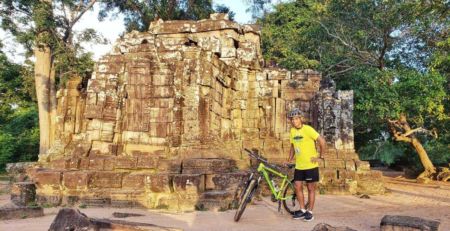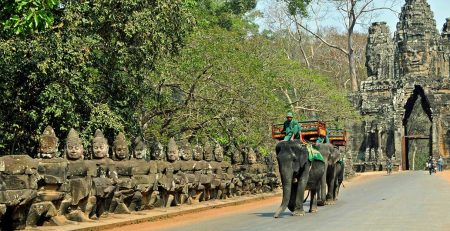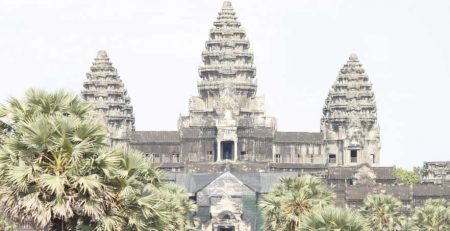10 Interesting facts about Angkor Archaeological Park , Siem Reap Cambodia
- While early Angkor temples were originally built as Hindu temples, Jayavarman VII who had converted to Mahayana Buddhism, built the new capital city of Angkor Thom including Bayon, Ta Prohm, Preah Khan & many more as Buddhist structures. However, his successor Jayavarman VIII was a follower of Hinduism and embarked on an equally massive spree of destruction, defacing Buddhist images & even crudely altering some to be Hindu again.
- The temple ruins contained within the Park represent the remnants of the millennium-old capitals of the old Khmer Empire. The Khmer people were & are the dominant ethnic group in Cambodia. Most of the temples within the park were constructed between the 9th and 12th A.D. and represent the pinnacle of ancient Khmer architecture, art and civilization. The capital city at Angkor was populated by more than a million people, Khmer kings constructed vast waterworks and grand temples and the Empire’s military, economic and cultural dominance held sway over the area of modern Cambodia, as well as much of Thailand, southern Vietnam and Laos. At its peak, the city occupied an area greater than modern Paris & its buildings used far more stone than all of the Egyptian structures combined.
- The Angkorian period probably began after 800 AD, when the Khmer King Jayavarman II announced the independence of Kambujadesa (Cambodia) from Java and established his capital of Hariharalaya (now known as Roluos) at the northern end of Tonlé Sap. Through a program of military campaigns, alliances, marriages and land grants, he achieved a unification of the country bordered by China to the north, Champa (now Central Vietnam) to the east, the ocean to the south and a place identified by a stone inscription as “the land of cardamoms and mangoes” to the west. In 802, Jayavarman articulated his new status by declaring himself as the “universal monarch” (chakravartin in Sanskrit). All the Kings constructed massive reservoirs in the city. The significance of such reservoirs has been debated by modern scholars, some of who believe they were built for irrigating rice fields, and others who regard the, as religiously charged symbols of the great mythological oceans surrounding Mount Meru, the abode of the gods.
- An idealized representation of the Hindu cosmos in stone, the temples range from great pyramidal temple-mountains of Angkor Wat and Pre Rup through to the complex monasteries of Ta Prohm and Banteay Kdei, as well as more miniature and intimate sanctuaries such as Thommanon and Preah Ko.
The various temples in the Angkor Archaeological Park had different roles to play in the Khmer regime. The story behind their existence is also varied . For instance Ta Prohm was a Buddhist temple dedicated to the mother of Jayavarman VII, however, it is also said to be named after Lord Brahma (Ta Prohm). One of the most famous spots in Ta Prohm is the so-called ‘Tomb Raider tree’, where Angelina Jolie’s Lara Croft picked a jasmine flower before falling through the earth into Pinewood Studios. Though the roots and branches have claimed most of the temple, it still stands tall showcasing the power of nature and man’s artisanship. The most talked about Temple complex of course is the Angkor Wat with its five magnificent corncob towers and vast complex of bas-relief galleries - Bayon has the smiling faces on each tower. While the faces are believed to have spiritual significance, considered to be the bodhisattva Lokesvara, these nevertheless resembled the King Jayavarman VII who got the temple constructed in the first place. Within walking distance of Bayon, is central Angkor Thom with its artistically interesting terraces and massive ‘temple-mountains,’ Baphuon and Phimeanakas. All the temples of Angkor Archaelogical Park are not at a walking distance and it takes time to travel from one end to the other. Travellers can either hire a taxi or tuk tuk to move around.
- The Roluos Group, which is comprised the monuments of an early Khmer capital, lies about 13 km west of Siem Reap. It is a bit out of the way, but offers some fine examples of early Angkorian art and a different experience. Even more distant temple, Banteay Srey (citadel of women and a shiva temple), should be a part of the plan.
- For almost six hundred years the area around Angkor Wat was the heart of the Khmer Empire. A ready supply of water and the fertility of the land meant that the area could support large populations, and successive Angkorian kings constructed their royal cities and state temples here. Despite the region’s importance, there’s a dearth of written records: the ancient Khmer wrote on specially treated palm trees or animal skins and none of their texts have survived. The history of Angkor has been pieced together through study of the temples and more than a thousand inscriptions– mostly written in Sanskrit – found across the empire.
- All travellers need an admission pass (an ‘Angkor Pass’) to visit the temples and sites in the Angkor Archaeological Park. Passes can be purchased at the main entrance on the road to Angkor Wat. Passes are available for one day, three days and seven days with validity ranging from 1 day to one month. 3 days pass is good to cover all the major temples. Don’t forget to carry a passport sized photo for the Angkor Pass to save time at the booking point. Besides, always have a schedule in place since all the temples are not very close to each otherand can’t be covered on foot. Angkor Archaeological park is open from 5 Am in the morning to 6 PM in the evening.
- Angkor Wat Sunrise and Sunset at Pre Rup temple complex should be a part of everyone’s itinerary. Besides, the nightlife in Siem Reap is a must experience after soaking in the majesty and history of temples. Don’t forget to visit the night market for souvenir shopping, and Pub street for some liquid Nirvana. A Pub called “Angkor What?“ is also a must visit.
- Best time to visit Angkor Archaeological Park is between October to March, the weather is pleasant, the rivers and waterfalls are in the best of their state.








Leave a Reply